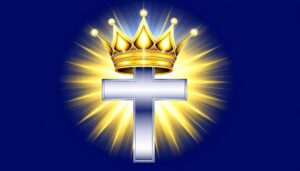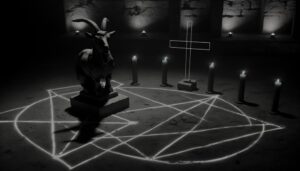A Guide to the Meaning of the Symbols on the El Salvador Flag
The flag of El Salvador, adopted on September 4, 1908, symbolizes the nation's historical journey and regional unity aspirations. The two blue stripes represent the Pacific Ocean and Caribbean Sea, emphasizing El Salvador's maritime heritage.
The central white stripe signifies peace, unity, and national purity. The coat of arms features a rainbow, five flags, a Phrygian cap, and a laurel wreath, each symbolizing hope, regional solidarity, liberty, and triumph, respectively.
These elements collectively illustrate El Salvador's commitment to autonomy, ethical governance, and integrity. Continue to uncover how each element embodies the nation's proud identity and values.
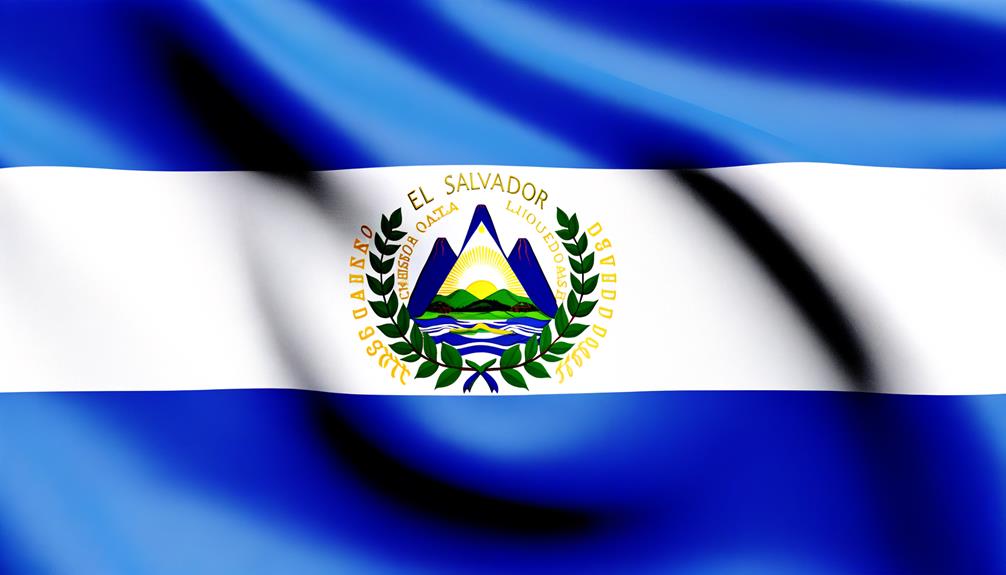
Key Takeaways
- The blue stripes symbolize El Salvador's Pacific and Caribbean maritime identity.
- The white stripe represents peace, unity, and national purity.
- The central rainbow symbolizes hope and the country's vibrant landscape.
- The Phrygian cap signifies liberty, freedom, and democratic ideals.
- The five flags commemorate the historical unity of Central American countries.
Historical Background
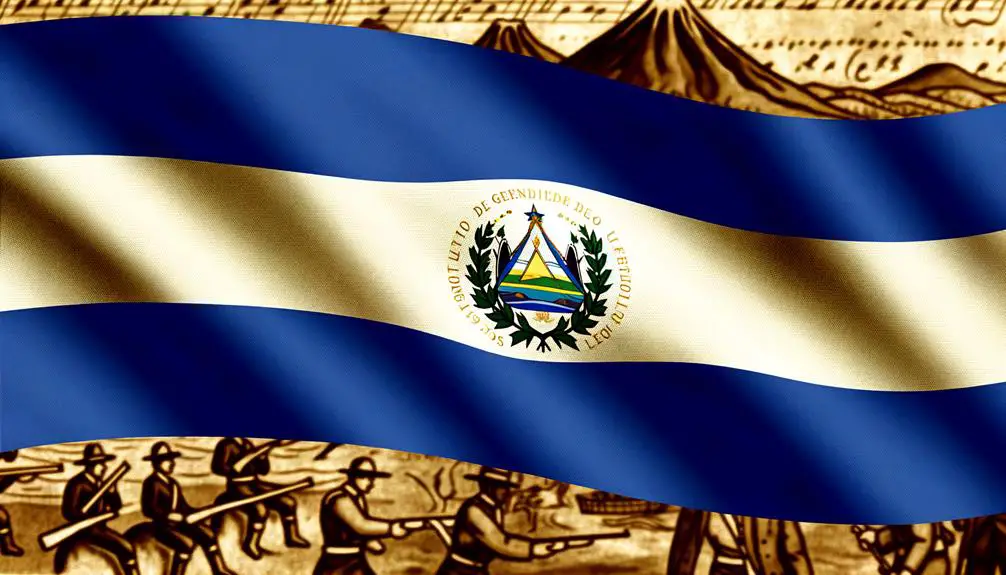
El Salvador's flag, adopted on September 4, 1908, has its origins deeply rooted in the historical influence of the United Provinces of Central America, a federation that existed from 1823 to 1839.
This federation comprised several Central American countries, including El Salvador, which sought unity and shared governance post-independence from Spain. The flag's design reflects this union, symbolizing a collective identity and aspiration for regional solidarity.
The historical context of the United Provinces is pivotal for understanding the flag's symbolism, as it encapsulates a period of political ambition and struggles for cohesive self-determination. The adoption of the flag in 1908 marked a reaffirmation of El Salvador's historical ties and enduring values derived from this formative era.
Blue Stripes
The blue stripes on El Salvador's flag, echoing the design of the United Provinces of Central America, symbolize the Pacific Ocean and the Caribbean Sea, illustrating the nation's geographical embrace. These dual blue bands are more than mere coloration; they represent El Salvador's integral connection to the vast bodies of water that flank its coasts and contribute to its maritime identity.
This design harks back to the early 19th century when Central American nations sought unity and commonality under shared symbols. Such imagery underscores El Salvador's historical and physical landscapes, melding the country's past aspirations for unity with its present geographical realities. The blue stripes thereby serve as enduring symbols of the nation's natural boundaries and heritage.
White Stripe
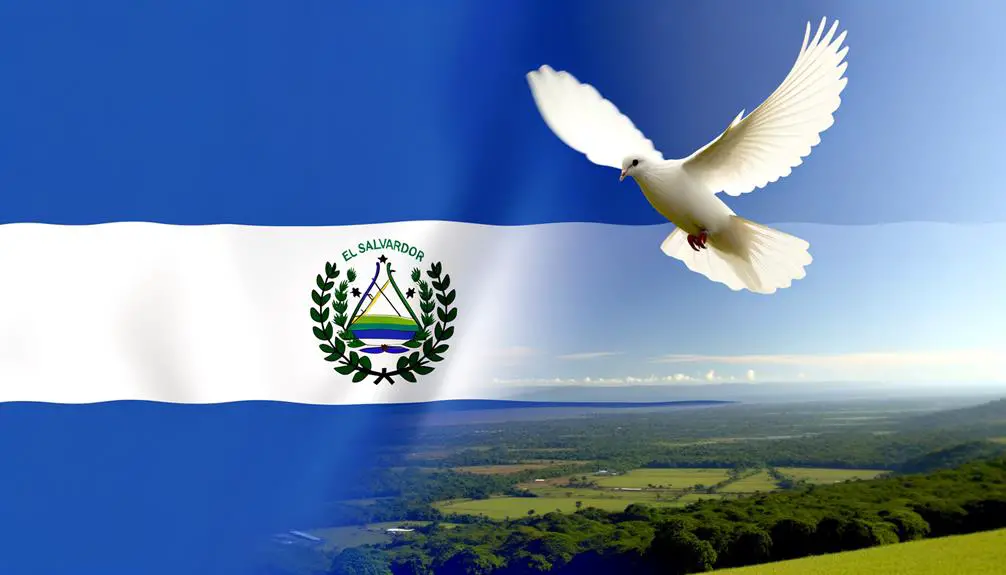
The white stripe in the center of the El Salvador flag is emblematic of peace and unity, symbolizing the nation's aspiration for harmony among its people.
It also represents national purity, reflecting the country's commitment to integrity and moral values.
Historically, the white stripe carries significant meaning, rooted in the country's journey toward independence and sovereign identity.
Peace and Unity
Representing peace and unity, the white stripe in the Salvadoran flag serves as a symbol of the nation's aspiration for harmony and collective identity. This emblematic color signifies the country's enduring hope for peaceful coexistence among its people. The white stripe is horizontally centered, flanked by blue stripes that mirror the sky and sea, further enhancing the flag's overall symbolism.
| Attribute | Description |
|---|---|
| Color | White |
| Position | Center horizontal stripe |
| Symbolism | Peace and unity |
| Complementary Colors | Blue (top and bottom stripes) |
| Context | National aspiration for harmony |
In a broader context, the white stripe's presence in the flag reflects El Salvador's commitment to fostering unity, transcending social and political divides.
National Purity Symbol
Beyond symbolizing peace and unity, the white stripe in El Salvador's flag also embodies the concept of national purity, reflecting the country's ideals of integrity and moral clarity. This symbolism is steeped in the nation's historical quest for ethical governance and societal honesty.
The white stripe serves as a visual reminder of the nation's commitment to upholding high moral standards in both public and private spheres. In a broader sense, it represents an aspiration towards a society free of corruption and moral ambiguity.
The prominence of this stripe in the flag underscores the importance of these values to the Salvadoran identity, reinforcing a collective sense of pride rooted in the country's moral fortitude and unwavering ethical principles.
Historical Significance Insight
Historically, the white stripe in El Salvador's flag traces its roots back to the nation's early struggles for independence and its enduring commitment to justice and fairness.
Adopted in 1912, the flag's white stripe symbolizes the unity and peace that the Central American Federation sought to establish following independence from Spanish rule in 1821. The white stripe, placed between two blue stripes, serves as a reminder of the ideals of equality and impartiality that the country endeavors to uphold.
It reflects the vision of a society where justice prevails, highlighting a collective aspiration for harmony amidst historical challenges. This symbolism continues to resonate, representing El Salvador's ongoing dedication to cultivating a just and equitable nation.
Coat of Arms
The Coat of Arms of El Salvador, prominently featured in the center of the national flag, is a complex emblem rich with historical and cultural significance. It showcases five volcanoes rising from the sea, symbolizing the five member states of the United Provinces of Central America.
Above the volcanoes, a red Phrygian cap, a symbol of liberty, is supported by golden rays and a rainbow, representing peace. Surrounding this imagery, the national motto 'Dios, Unión, Libertad' translates to 'God, Union, Liberty.'
The emblem is encircled by the words 'República de El Salvador en la América Central,' denoting the nation's official name. This intricate design reflects El Salvador's commitment to unity, freedom, and heritage.
The Triangle
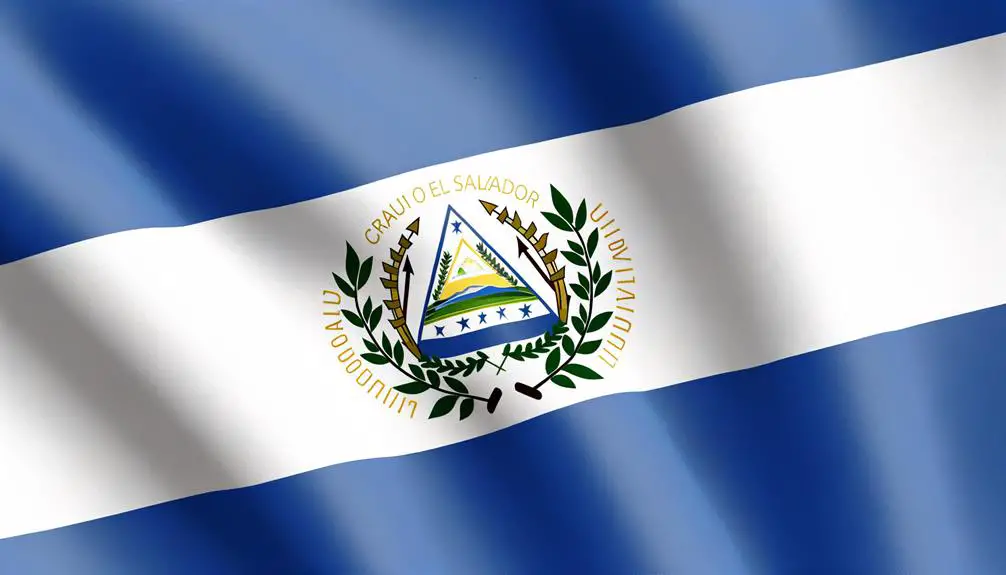
The triangle in El Salvador's flag is a powerful symbol of equality and unity, framed by three points that represent the pillars of liberty, equality, and fraternity.
Its historical significance is rooted in the ideals of the French Revolution, which influenced many Latin American countries during their struggles for independence.
This geometric figure underscores the nation's commitment to these foundational principles, thereby providing context to the broader symbolism embedded in the flag.
Symbolic Representation
A prominent feature of the El Salvador flag, the triangle, encapsulates profound symbolic meaning that reflects the nation's ideals and aspirations. Positioned centrally within the flag's design, the equilateral triangle signifies equality and justice. Each of its three sides represents the three branches of government: executive, legislative, and judicial, underscoring the nation's commitment to balanced governance and rule of law.
Within the triangle, five volcanoes emerge from the sea, symbolizing the unity and strength of the five Central American republics. Above the volcanoes, a red Phrygian cap on a staff signifies liberty and freedom, while the array of rays from the golden sun emphasizes enlightenment and hope. Together, these elements foster a deep sense of national pride and identity.
Historical Significance
Tracing the historical roots of the triangle within the El Salvador flag reveals its profound connection to the ideals of liberty and justice established during the country's early struggles for independence.
The equilateral triangle, prominently featured in the national emblem, symbolizes equality among all citizens. This geometric representation dates back to the formation of the United Provinces of Central America in 1823, a coalition aimed at unifying the region under shared principles of freedom.
The three points of the triangle stand for the three branches of government—executive, legislative, and judicial—each playing a pivotal role in maintaining democratic governance. The triangle's presence on the flag underscores El Salvador's enduring commitment to these foundational values amid its evolving national identity.
The Rainbow
In the context of El Salvador's flag, the rainbow symbolizes the aspirations for peace and unity among the nation's people.
Represented in the national coat of arms, which is central to the flag, the rainbow arches above five volcanoes, reflecting the country's vibrant landscape.
Historically, rainbows have been seen as symbols of hope and a bridge between different territories.
For El Salvador, the rainbow illustrates a collective desire to transcend past conflicts and foster a harmonious future.
This emblematic feature underscores an enduring commitment to solidarity and a shared vision for a prosperous nation, aligning with broader themes of reconciliation and national identity.
Thus, the rainbow remains a poignant and unifying element on the flag.
Phrygian Cap
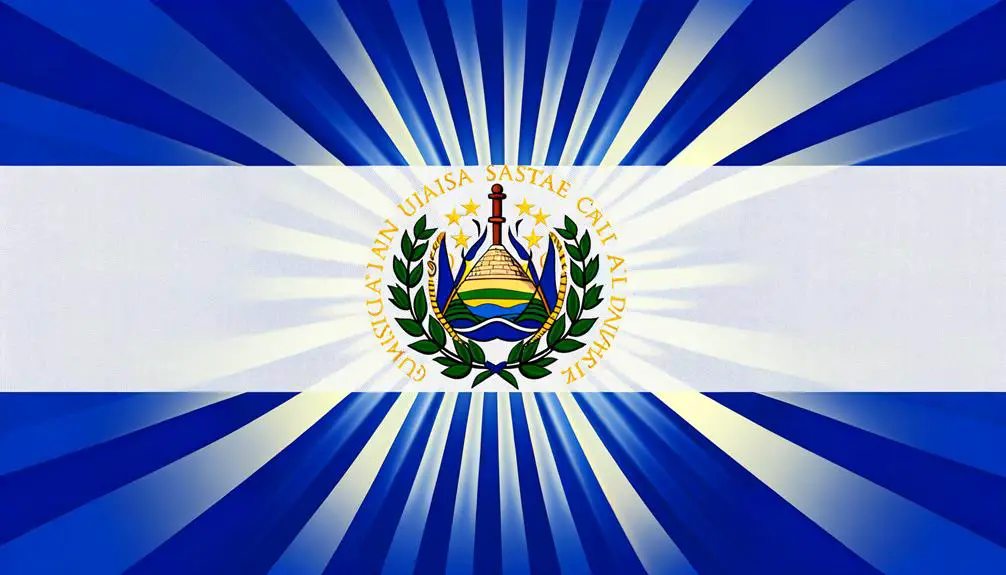
The Phrygian Cap, prominently featured in the national coat of arms on El Salvador's flag, symbolizes liberty and freedom, drawing from its historical association with the pursuit of emancipation and resistance against oppression.
Originating in ancient Phrygia, this soft, conical cap was adopted by freed slaves in Rome and later became an emblem of the French Revolution. Its inclusion in El Salvador's coat of arms reflects the nation's enduring commitment to democratic ideals and the struggle for autonomy.
Positioned above a golden staff and radiating rays of light, the Phrygian Cap serves as a powerful reminder of the nation's historical and ongoing quest for sovereignty, justice, and the protection of individual rights.
Five Flags
At the heart of El Salvador's national coat of arms, five distinct flags represent the five member states of the United Provinces of Central America, symbolizing a shared historical and cultural heritage. These flags are emblematic of the unity and cooperation that once existed among the nations of this region. Each flag contributes to a collective identity that underscores their common roots and aspirations.
Key aspects of the five flags include:
- Symbolism: They represent Guatemala, Honduras, El Salvador, Nicaragua, and Costa Rica.
- Design: Each flag maintains the blue and white color scheme, reflecting unity.
- Historical significance: They commemorate the 1823 federation that sought regional solidarity.
- Position: Arranged in a semi-circle above the coat of arms, emphasizing unity.
Laurel Wreath
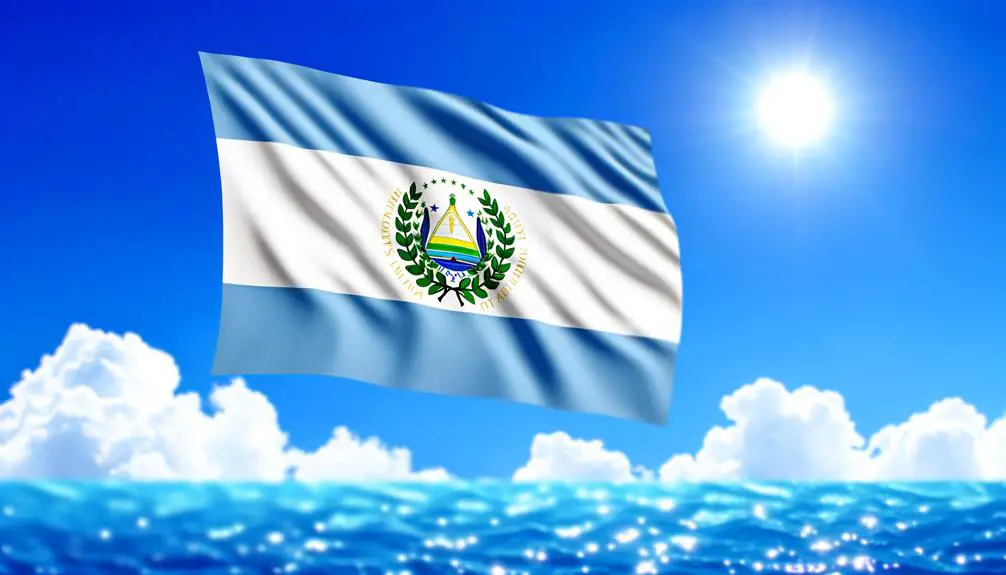
The laurel wreath on the El Salvador flag holds historical significance as a traditional symbol of victory and honor, often linked to ancient Greek and Roman traditions. Its inclusion reflects the country's aspirations towards peace and triumph, encapsulating a message of enduring national pride.
Symbolically, the wreath also conveys unity and resilience, reinforcing the values El Salvador seeks to project both domestically and internationally.
Historical Significance
Symbolizing peace and victory, the laurel wreath on the El Salvador flag encapsulates the country's aspirations and achievements throughout its history. This emblem traces its roots back to ancient Greece and Rome, where it was awarded to victors in athletic competitions and battles. Its inclusion in the national flag signifies a deep connection to these ideals.
The laurel wreath represents:
- Independence: A nod to El Salvador's liberation from Spanish colonial rule in 1821.
- Unity: Reflects the unity of Central American nations within the Federal Republic of Central America.
- Sovereignty: Asserts El Salvador's autonomy and national pride.
- Endurance: Symbolizes the resilience and fortitude of the Salvadoran people.
The laurel wreath serves as a tribute to El Salvador's enduring spirit.
Symbolic Interpretation
Embedded within the El Salvador flag, the laurel wreath serves as a powerful emblem encapsulating the nation's ideals of independence, unity, sovereignty, and endurance. This circular arrangement of laurel branches is a classical symbol, historically associated with victory and honor.
In the context of El Salvador, the laurel wreath signifies the triumph of the nation over colonial rule and its enduring spirit in the face of adversity. Encircling five blue and white flags representing the United Provinces of Central America, the wreath also highlights unity among these nations.
The inclusion of the laurel wreath in the national flag underscores El Salvador's commitment to maintaining its hard-won freedom and fostering a sense of collective identity and resilience.
Significance of Colors
Reflecting the nation's history and ideals, the colors of the El Salvador flag each hold significant and distinct meanings that contribute to the overall symbolism of the flag.
The flag features three horizontal stripes: blue, white, and blue. Each color is imbued with profound importance:
- Blue: Represents the Pacific Ocean and Caribbean Sea, symbolizing the nation's maritime heritage.
- White: Denotes peace and unity, reflecting the country's aspiration for harmony.
- Blue: Reiterates the ideals of the first blue stripe, emphasizing the nation's geographical and cultural ties to the sea.
- Overall Arrangement: The use of two blue stripes flanking a white stripe underscores the balance between tranquility and the enduring natural beauty of El Salvador.
These colors collectively express the nation's sovereignty and the values its people cherish.
Conclusion
The flag of El Salvador, with its intricate symbols and colors, serves as a vivid tapestry of the nation's identity and ideals. The blue and white stripes embody aspirations for peace and unity, while the coat of arms, replete with a Phrygian cap, five flags, and a laurel wreath, encapsulates a rich historical legacy and a commitment to liberty.
Like a historical manuscript, the flag narrates the story of a nation's enduring quest for sovereignty and harmony.


